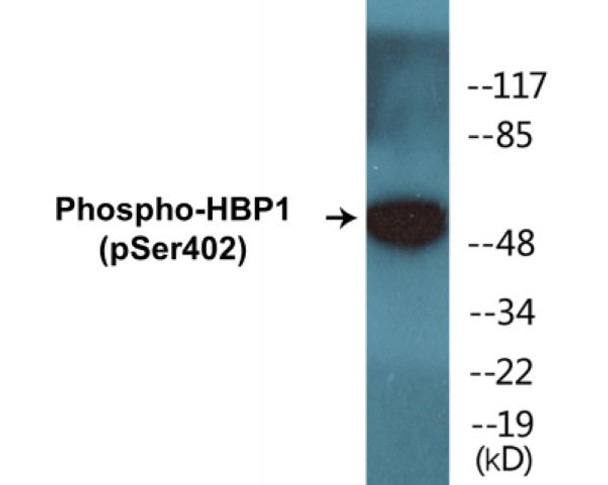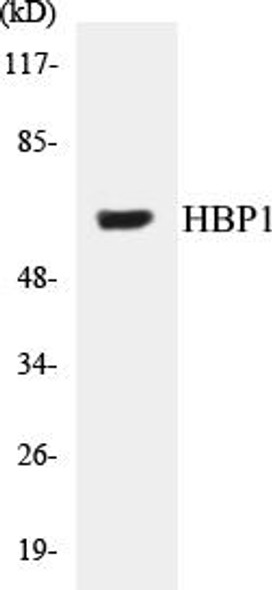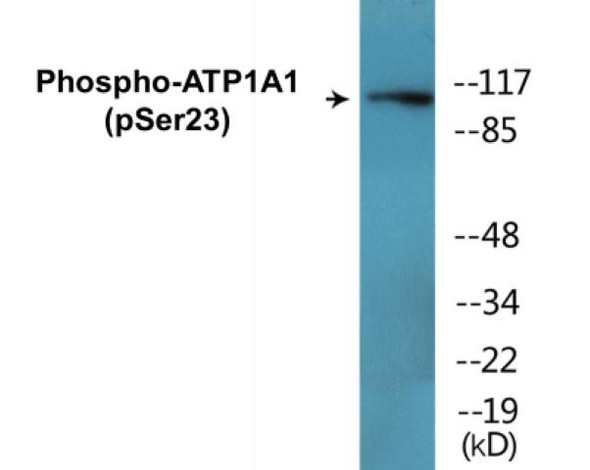HBP1 (Phospho-Ser402) Colorimetric Cell-Based ELISA Kit
- SKU:
- CBCAB01448
- Product Type:
- ELISA Kit
- ELISA Type:
- Cell Based Phospho Specific
- Research Area:
- Epigenetics and Nuclear Signaling
- Reactivity:
- Human
- Detection Method:
- Colorimetric
Description
HBP1 (Phospho-Ser402)Colorimetric Cell-Based ELISA Kit
The HBP1 Phospho-Ser402 Colorimetric Cell-Based ELISA Kit is specifically designed for the accurate detection of HBP1 phosphorylation at serine 402 in cell lysates. This kit offers high sensitivity and specificity, allowing for reliable and reproducible results in a variety of research applications.HBP1, also known as high mobility group box protein 1, plays a critical role in regulating cell cycle progression and cell proliferation. Phosphorylation of HBP1 at serine 402 has been linked to various cellular pathways and signaling cascades, making it a key target for understanding cellular processes and disease mechanisms.
By using the HBP1 Phospho-Ser402 Colorimetric Cell-Based ELISA Kit, researchers can gain valuable insights into the phosphorylation status of HBP1 in cells, helping to further our understanding of its role in health and disease. This kit is a valuable tool for studying signal transduction pathways, drug discovery, and biomarker research in various fields of biomedical science.
| Product Name: | HBP1 (Phospho-Ser402) Colorimetric Cell-Based ELISA |
| Product Code: | CBCAB01448 |
| ELISA Type: | Cell-Based |
| Target: | HBP1 (Phospho-Ser402) |
| Reactivity: | Human |
| Dynamic Range: | > 5000 Cells |
| Detection Method: | Colorimetric 450 nm |
| Format: | 2 x 96-Well Microplates |
The HBP1 (Phospho-Ser402) Colorimetric Cell-Based ELISA Kit is a convenient, lysate-free, high throughput and sensitive assay kit that can detect HBP1 protein phosphorylation and expression profile in cells. The kit can be used for measuring the relative amounts of phosphorylated HBP1 in cultured cells as well as screening for the effects that various treatments, inhibitors (ie. siRNA or chemicals), or activators have on HBP1 phosphorylation.
Qualitative determination of HBP1 (Phospho-Ser402) concentration is achieved by an indirect ELISA format. In essence, HBP1 (Phospho-Ser402) is captured by HBP1 (Phospho-Ser402)-specific primary (1ø) antibodies while the HRP-conjugated secondary (2ø) antibodies bind the Fc region of the 1ø antibody. Through this binding, the HRP enzyme conjugated to the 2ø antibody can catalyze a colorimetric reaction upon substrate addition. Due to the qualitative nature of the Cell-Based ELISA, multiple normalization methods are needed:
| 1. | A monoclonal antibody specific for human GAPDH is included to serve as an internal positive control in normalizing the target absorbance values. |
| 2. | Following the colorimetric measurement of HRP activity via substrate addition, the Crystal Violet whole-cell staining method may be used to determine cell density. After staining, the results can be analysed by normalizing the absorbance values to cell amounts, by which the plating difference can be adjusted. |
| Database Information: | Gene ID: 26959, UniProt ID: O60381, OMIM: None, Unigene: Hs.162032 |
| Gene Symbol: | HBP1 |
| Sub Type: | Phospho |
| UniProt Protein Function: | HBP1: Transcriptional repressor that binds to the promoter region of target genes. Plays a role in the regulation of the cell cycle and of the Wnt pathway. Binds preferentially to the sequence 5'-TTCATTCATTCA-3'. Binding to the H1F0 promoter is enhanced by interaction with RB1. Disrupts the interaction between DNA and TCF4. 3 isoforms of the human protein are produced by alternative splicing. |
| UniProt Protein Details: | Protein type:Transcription factor; DNA-binding Chromosomal Location of Human Ortholog: 7q22.3 Cellular Component: nucleoplasm Molecular Function:protein binding; DNA binding; RNA binding Biological Process: Wnt receptor signaling pathway; regulation of transcription, DNA-dependent; transcription, DNA-dependent; positive regulation of potassium ion transport; cell cycle arrest |
| UniProt Code: | O60381 |
| NCBI GenInfo Identifier: | 346716352 |
| NCBI Gene ID: | 26959 |
| NCBI Accession: | NP_001231191.1 |
| UniProt Secondary Accession: | O60381,Q8TBM1, Q8TE93, Q96AJ2, B3KVB7, |
| UniProt Related Accession: | O60381 |
| Molecular Weight: | 57,645 Da |
| NCBI Full Name: | HMG box-containing protein 1 isoform 1 |
| NCBI Synonym Full Names: | HMG-box transcription factor 1 |
| NCBI Official Symbol: | HBP1 |
| NCBI Protein Information: | HMG box-containing protein 1; HMG box transcription factor 1; high mobility group box transcription factor 1 |
| UniProt Protein Name: | HMG box-containing protein 1 |
| UniProt Synonym Protein Names: | HMG box transcription factor 1; High mobility group box transcription factor 1 |
| Protein Family: | HMG box-containing protein |
| UniProt Gene Name: | HBP1 |
| UniProt Entry Name: | HBP1_HUMAN |
| Component | Quantity |
| 96-Well Cell Culture Clear-Bottom Microplate | 2 plates |
| 10X TBS | 24 mL |
| Quenching Buffer | 24 mL |
| Blocking Buffer | 50 mL |
| 15X Wash Buffer | 50 mL |
| Primary Antibody Diluent | 12 mL |
| 100x Anti-Phospho Target Antibody | 60 µL |
| 100x Anti-Target Antibody | 60 µL |
| Anti-GAPDH Antibody | 60 µL |
| HRP-Conjugated Anti-Rabbit IgG Antibody | 12 mL |
| HRP-Conjugated Anti-Mouse IgG Antibody | 12 mL |
| SDS Solution | 12 mL |
| Stop Solution | 24 mL |
| Ready-to-Use Substrate | 12 mL |
| Crystal Violet Solution | 12 mL |
| Adhesive Plate Seals | 2 seals |
The following materials and/or equipment are NOT provided in this kit but are necessary to successfully conduct the experiment:
- Microplate reader able to measure absorbance at 450 nm and/or 595 nm for Crystal Violet Cell Staining (Optional)
- Micropipettes with capability of measuring volumes ranging from 1 µL to 1 ml
- 37% formaldehyde (Sigma Cat# F-8775) or formaldehyde from other sources
- Squirt bottle, manifold dispenser, multichannel pipette reservoir or automated microplate washer
- Graph paper or computer software capable of generating or displaying logarithmic functions
- Absorbent papers or vacuum aspirator
- Test tubes or microfuge tubes capable of storing ≥1 ml
- Poly-L-Lysine (Sigma Cat# P4832 for suspension cells)
- Orbital shaker (optional)
- Deionized or sterile water
*Note: Protocols are specific to each batch/lot. For the correct instructions please follow the protocol included in your kit.
| Step | Procedure |
| 1. | Seed 200 µL of 20,000 adherent cells in culture medium in each well of a 96-well plate. The plates included in the kit are sterile and treated for cell culture. For suspension cells and loosely attached cells, coat the plates with 100 µL of 10 µg/ml Poly-L-Lysine (not included) to each well of a 96-well plate for 30 minutes at 37 °C prior to adding cells. |
| 2. | Incubate the cells for overnight at 37 °C, 5% CO2. |
| 3. | Treat the cells as desired. |
| 4. | Remove the cell culture medium and rinse with 200 µL of 1x TBS, twice. |
| 5. | Fix the cells by incubating with 100 µL of Fixing Solution for 20 minutes at room temperature. The 4% formaldehyde is used for adherent cells and 8% formaldehyde is used for suspension cells and loosely attached cells. |
| 6. | Remove the Fixing Solution and wash the plate 3 times with 200 µL 1x Wash Buffer for five minutes each time with gentle shaking on the orbital shaker. The plate can be stored at 4 °C for a week. |
| 7. | Add 100 µL of Quenching Buffer and incubate for 20 minutes at room temperature. |
| 8. | Wash the plate 3 times with 1x Wash Buffer for 5 minutes each time. |
| 9. | Add 200 µL of Blocking Buffer and incubate for 1 hour at room temperature. |
| 10. | Wash 3 times with 200 µL of 1x Wash Buffer for 5 minutes each time. |
| 11. | Add 50 µL of 1x primary antibodies Anti-HBP1 (Phospho-Ser402) Antibody, Anti-HBP1 Antibody and/or Anti-GAPDH Antibody) to the corresponding wells, cover with Parafilm and incubate for 16 hours (overnight) at 4 °C. If the target expression is known to be high, incubate for 2 hours at room temperature. |
| 12. | Wash 3 times with 200 µL of 1x Wash Buffer for 5 minutes each time. |
| 13. | Add 50 µL of 1x secondary antibodies (HRP-Conjugated AntiRabbit IgG Antibody or HRP-Conjugated Anti-Mouse IgG Antibody) to corresponding wells and incubate for 1.5 hours at room temperature. |
| 14. | Wash 3 times with 200 µL of 1x Wash Buffer for 5 minutes each time. |
| 15. | Add 50 µL of Ready-to-Use Substrate to each well and incubate for 30 minutes at room temperature in the dark. |
| 16. | Add 50 µL of Stop Solution to each well and read OD at 450 nm immediately using the microplate reader. |
(Additional Crystal Violet staining may be performed if desired – details of this may be found in the kit technical manual.)










